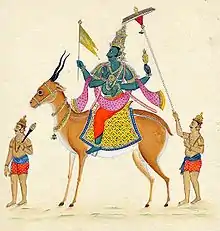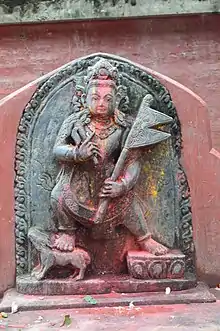Vayu
Vayu (Sanskrit pronunciation: [ʋaːjʊ], Sanskrit: वायु, IAST: Vāyu) is a primary Hindu deity, the lord of the winds as well as deity of breath and the spiritual father of Hanuman and Bhima. He is also known as Anila ('air, wind'), Vyāna ('air'), Vāta ('airy element'), Tanuna ('the wind'), Pavana ('the purifier'),[5] and sometimes Prāṇa ('the breath'). Madhvacharya is considered the third incarnation of Vayu by Madhwa Brahmins.
| Vāyu | |
|---|---|
| Member of the Pancha Bhoota | |
 Vayu, on his mount, the gazelle, symbolizing swiftness | |
| Other names | Anil, Pavan, Vyān, Vāta, Tanun, Mukhyaprana, Bharati Ramana, Bheema |
| Devanagari | वायु |
| Sanskrit transliteration | Vāyu |
| Affiliation | Deva, Mukhyaprana and Pavamana |
| Abode | Pawanloka |
| Mantra | Om Vayave namaha |
| Weapon | Goad |
| Mount | Gazelle |
| Personal information | |
| Parents | |
| Consort | Bharati or Svasti[3][4] |
| Children | |
| Classical elements |
|---|
|
Stoicheion (στοιχεῖον) |
|
Wuxing (五行) |
|
Godai (五大) |
|
Bön |
|
Alchemy |
Connotations
The word for air (vāyu) or wind (pavana) is one of the classical elements in Hinduism. The Sanskrit word Vāta literally means 'blown'; Vāyu, 'blower' and Prāna, 'breathing' (viz. the breath of life, cf. the *an- in animate). Hence, the primary referent of the word is the 'deity of life', who is sometimes for clarity referred to as Mukhya-Vāyu (the chief Vayu) or Mukhya Prāna (the chief of life).
Sometimes the word vāyu, which is more generally used in the sense of the physical air or wind, is used as a synonym for prāna.[6] Vāta, an additional name for the deity Vayu, is the root of vātāvaranam, the Sanskrit and Hindi term for 'atmosphere'.[7]
Pavana played an important role in Anjana's begetting Hanuman as her child so Hanuman is also called Pavanaputra 'son of Pavana' and Vāyuputra. Today, Pavan is a fairly common Hindu name.
In the Mahabharata, Bhima was the spiritual son of Vayu and played a major role in the Kurukshetra War. He utilised his huge power and skill with the mace for supporting Dharma.
Hindu texts and philosophy

In the Rigveda, Vayu is associated with the winds, with the Maruts being described as being born from Vayu's belly. Vayu is also the first god to receive soma in the ritual, and then he and Indra share their first drink.[8]
In the hymns, Vayu is 'described as having "exceptional beauty" and moving noisily in his shining coach, driven by two or forty-nine or one-thousand white and purple horses. A white banner is his main attribute'.[5] Like the other atmospheric deities, he is a 'fighter and destroyer', 'powerful and heroic'.[9]
In the Upanishads, there are numerous statements and illustrations of the greatness of Vayu. The Brihadaranyaka Upanishad says that the gods who control bodily functions once engaged in a contest to determine who among them is the greatest. When a deity such as that of vision would leave a man's body, that man would continue to live, albeit as a blind man and having regained the lost faculty once the errant deity returned to his post. One by one the deities all took their turns leaving the body, but the man continued to live on, though successively impaired in various ways. Finally, when Mukhya Prāna started to leave the body, all the other deities started to be inexorably pulled off their posts by force, 'just as a powerful horse yanks off pegs in the ground to which he is bound'. This caused the other deities to realize that they can function only when empowered by Vayu, and can be overpowered by him easily. In another episode, Vayu is said to be the only deity not afflicted by demons of sin who were on the attack. The Chandogya Upanishad says that one cannot know Brahman except by knowing Vayu as the udgitha (the mantric syllable om).[10]
- The first avatar of Vayu is considered to be Hanuman. His exploits are elucidated in Ramayana.
- The second avatar of Vayu is Bhima, one of the Pandavas appearing in the epic the Mahabharata.[11]
- According to Madhwa Brahmins, the third avatar is identified with Madhvacharya, a 13th century Indian philosopher.[12][13]
Buddhism
In East Asian Buddhism, Vayu is a dharmapāla and often classed as one of the Twelve Devas (Japanese: Jūniten, 十二天) grouped together as directional guardians. He presides over the northwest direction.[14]
In Japan, he is called Fūten. He is included with the other eleven devas, which include Taishakuten (Śakra/Indra), Katen (Agni), Enmaten (Yama), Rasetsuten (Nirṛti/Rākṣasa), Ishanaten (Īśāna), Bishamonten (Vaiśravaṇa/Kubera), Suiten (Varuṇa) Bonten (Brahmā), Jiten (Pṛthivī), Nitten (Sūrya/Āditya) and Gatten (Candra).[15]
In popular culture
| Year | Name | Channel | Country | Played by |
|---|---|---|---|---|
| 1997 | Jai Hanuman | DD Metro | India | Nimai Bali |
| 2015 | Sankatmochan Mahabali Hanuman | Sony Entertainment Television | India | Manish Bishla |
| 2017 | Mahakaali Anth Hi Aarambh Hai | Colors | India | Hitanshu Jinsi |
| 2019 | Vighnaharta Ganesh | Sony Entertainment Television | India | Vikas Salgotra |
See also
| Wikimedia Commons has media related to Vayu. |
- List of wind deities
- Maruts
- Rudras
- Rudra, the Vedic wind or storm God.
- Vayu Purana
- Vayu-Vata
References
- The Rāmāyaṇa of Vālmīki: An Epic of Ancient India, Volume VII: Uttarakāṇḍa. Princeton University Press. 20 December 2016. ISBN 978-1-4008-8456-8.
- Lavanya Vemsani (13 June 2016). Krishna in History, Thought, and Culture: An Encyclopedia of the Hindu Lord of Many Names: An Encyclopedia of the Hindu Lord of Many Names. ABC-CLIO. p. 163. ISBN 9781610692113.
- M. V. Krishna Rao (1966). Purandara and the Haridasa Movement. Karnatak University. p. 200.
- Kindler, Babaji Bob (4 July 1996). Twenty-Four Aspects of Mother Kali. SRV Associations. ISBN 978-1-891893-17-9.
- Eva Rudy Jansen; Tony Langham (1993), The book of Hindu imagery: The Gods and their Symbols, Binkey Kok Publications, ISBN 978-90-74597-07-4,
God of the wind ... also known as Vata or Pavan ... exceptional beauty ... moves on noisily in his shining coach ... white banner ...
- Raju, P.T. (1954), "The concept of the spiritual in Indian thought", Philosophy East and West, 4 (3): 195–213, doi:10.2307/1397554, JSTOR 1397554.
- Vijaya Ghose; Jaya Ramanathan; Renuka N. Khandekar (1992), Tirtha, the treasury of Indian expressions, CMC Limited, ISBN 978-81-900267-0-3,
... God of the winds ... Another name for Vayu is Vata (hence the present Hindi term for 'atmosphere, 'vatavaran). Also known as Pavana (the purifier), Vayu is lauded in both the ...
- Stephanie Jamison (2015). The Rigveda –– Earliest Religious Poetry of India. Oxford University Press. p. 47. ISBN 978-0190633394.
- Sukumari Bhattacharji (1984), Literature in the Vedic age, K.P. Bagchi,
... The other atmospheric gods are his associates: Vayu-Vatah, Parjanya, the Rudras and the Maruts. All of them are fighters and destroyers, they are powerful and heroic ...
- Chandogya Upanishad, Adhyaya XVIII, Verse 4; http://www.swamij.com/upanishad-chandogya.htm
- "The Mahabharata, Book 1: Adi Parva: Sambhava Parva: Section LXVII".
- History of the Dvaita School and Its literature, pg 173
- "Balittha Suktha -Text From Rig Veda". raghavendramutt.org. Archived from the original on 24 September 2016.
- Twelve Heavenly Deities (Devas) Nara National Museum, Japan
- "juuniten 十二天". JAANUS. Retrieved 23 January 2019.
